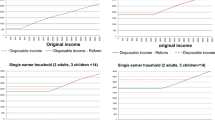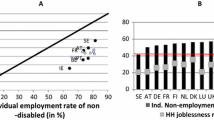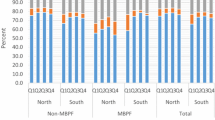Abstract
We investigate the added worker effect in a setting where female labour supply is high and the welfare state is generous. We trace couples’ labour supply and income development following the husband’s job displacement. We find no support for the added worker effect for the full sample of households. However, the added worker effect seems to be at work for subsamples characterised by households where the spouses are not working in the same industry and where the wife did not work full time pre-displacement. When using a measure of total household income, which includes public transfers, we find that the negative income impact of displacement is reduced by approximately 60 to 70 % when we also adjust for lower tax payments. Results suggest that income loss due to displacement is mitigated more by social welfare payments than by labour supply responses of the spouse.
Similar content being viewed by others
Notes
In our sample, approximately 7 % of couples divorced in the period 2001–2005. Furthermore, we find a positive correlation between experiencing a displacement and the likelihood of divorce. However, running a regression on the whole sample (including future divorced couples) did not change the coefficients significantly. The main change is in having somewhat more precise coefficients when we focused on couples who remained married. The results are available upon request.
Workers who left plants in 2002 but who are not classified as displaced are included in the analysis sample.
NACE is the European Industrial Activity Classification.
Approximately 0.15 euro is equal to 1 NOK. Therefore, 20,000 NOK is, equal to approximately 3,000 euro.
We have also experimented with a specification where, in addition to the chosen sample selection, we also required that the husband should have more than 1 year seniority. This did not change the results significantly. The only visible difference was somewhat stronger wage effects.
Note that we do not require that people report a positive labour income for them to be included in the labour income analyses. People without a reported labour income are given the value of 0. Since we are interested in the labour supply of the wife in the aftermath of displacement, we think it is necessary to include also those husbands who are not employed.
With regard to the control variables, we find that labour supply increases with the wives’ own education and work experience. It is lower for women with children, especially among those with small children (younger than 6). Labour supply also decreases with the level of the wife’s wealth. With regard to the husband’s characteristics, the wife’s labour supply decreases with the age of the husband. With regard to the husband’s education, we do not find a monotonic relationship, as is the case for the wife’s own education. If the husband has higher education, particularly if he has a university or college degree of the highest level, this is negatively related to the spouse’s labour supply. This result is indicative of specialisation within the household. The level of wealth of the husband is also negatively related to the labour supply of the wife. Finally, the level of unemployment in the county is also negatively related to the labour supply of the wife.
The importance of this phenomenon is also presented in Juhn and Potter (2007). They use matched March CPS files to examine labour market transitions for husbands and wives. They find that the added worker effect is still important among a subset of couples but that the overall value of marriage as a risk-sharing arrangement has diminished due to the greater positive co-movement of employment within couples.
All analyses so far have focused on Norwegian natives. As an extra exercise, we have undertaken analyses for immigrants as well. We distinguish between non-Western and Western immigrants. The overall impression from these analyses is small and statistically insignificant responses. This is especially true for non-Western immigrants and might suggest that they are heavily limited on the demand side, in the sense that their productivity is too low compared to the requirements in the labour market. Such an explanation is particularly feasible in an economy such as the Norwegian one, which is characterised by a compressed wage structure, especially at the lower end of the wage distribution. The consequence is high wage floors, which is hard to reach for non-Western immigrant women.
In the last set of analyses, we reverse the setting: we consider the situation where the wife is displaced and we investigate whether there is any labour supply response from the husband. The results show (these are not reported but are available upon request) that the wife’s displacement does not trigger any response in the husband’s labour market behaviour. This result applies in general and also for subsets of couples.
Unemployment benefit is conditional on recent work experience. Compensation amounts to 62.5 % of previous labour income, and duration is of maximum 1.5 years depending on previous wage income.
Rehabilitation benefits involve both medical rehabilitation and vocational rehabilitation, which are measures intended to help individual back to work. Rehabilitation benefits can last for several years and provide the same level of compensation as unemployment benefits. Disability benefits are compensation for loss of income from employment in the event of occupational disability due to illness or injury. Disability benefit is calculated the same way as old-age pension on the basis of past earning and expected earnings in the absence of disability.
Childcare benefit is granted when the child must be looked after by someone else during working hours or training courses. The benefit amount is set at 64 % of actual childcare expenses up to a certain annual ceiling. When income from work exceeds six times the basic amount, there is no right to childcare benefit.
The progressive tax system of Norway means the lower labour income (due to displacement), the lower is income tax.
References
Couch KA, Placzek DW (2010) Earnings losses of displaced workers revisited. Am Econ Rev 100:572–589
Eliason M, Storrie D (2006) Lasting or latent scars? Swedish evidence on the long-term effects of job displacement. J Labor Econ 24:831–856
Eliasson M (2012) Lost jobs, broken marriages. J Popul Econ 25:1365–1397
Heckman J, Robb R (1985) Alternative methods for evaluating the impact of interventions. In: Heckman J, Singer B (eds) Longitudinal analyses of the labour market data. Cambridge University Press, Cambridge, pp 156–245
Huttunen K, Møen J, Salvanes KG (2011) How destructive is creative destruction? Effects of job loss on mobility, withdrawal and income. J Eur Econ Ass 9:840–870
Jacobson LS, LaLonde R, Sullivan D (1993) Earnings losses of displaced workers. Am Econ Rev 83:685–709
Juhn C, Potter S (2007) Is there still an added worker effect? Federal Reserve Bank of New York Staff report No. 310
Lalonde R (1986) Evaluating the econometric evaluations of training programs with experimental data. Am Econ Rev 76:604–620
Lundberg S (1985) The added worker effect. J Lab Econ 3(1):11–37
Malony T (1987) Employment constraints and labour supply of married women. A re-examining of the added worker effect. J Hum Resour 22:51–61
OECD (2011) Employment Outlook. OECD Paris
Rege M, Telle K, Votruba M (2007) Plant closure and marital dissolution. Research Department, Statistics Norway, discussion paper 514
Ruhm CJ (1991) Are workers permanently scarred by job displacement?Am Econ Rev 81:319–324
Røed K, Fevang E (2007) Organizational change, absenteeism, and welfare dependency. J Hum Resour 42:156–193
Spletzer JR (1997) Reexamining the added worker effect. Econ Inq 35:417–427
Stephens M (2002) Worker displacement and the added worker effect. J Labor Econ 20:504–537
Stevens AH (1997) Persistent effects of job displacement: The importance of multiple job losses. J Labor Econ 1(5):165–188
Acknowledgments
The Norwegian Research Council projects ‘Public Policy and the Labour Market Attachment of Different Households’ and ‘Trygd i kontekst. Rettferdighet, effektivitet, fordeling’ financed this study. The authors gratefully acknowledge this financial support.
Author information
Authors and Affiliations
Corresponding author
Additional information
Responsible editor: Junsen Zhang
Appendix
Appendix
Rights and permissions
About this article
Cite this article
Hardoy, I., Schøne, P. Displacement and household adaptation: insured by the spouse or the state?. J Popul Econ 27, 683–703 (2014). https://doi.org/10.1007/s00148-013-0469-5
Received:
Accepted:
Published:
Issue Date:
DOI: https://doi.org/10.1007/s00148-013-0469-5




